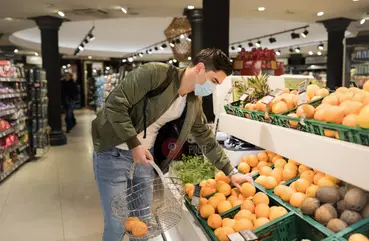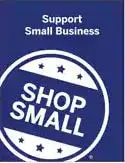 Adjusting to life under siege by SARS-CoV-2 has not been easy; each new day brings with it novel guidelines and restrictions aimed at keeping populations safe as cases soar worldwide. Many of us—most of us, I hope—are staying at home as much as possible to give hospital workers a fighting chance at saving the lives affected by COVID-19. Still, there is one place few of us can avoid: the grocery store. Everyone needs food, and while grocery delivery is still available in some places—albeit with weeks-long wait times—most of us will be forced to venture out sometime in the next month (or more) to restock our shelves. It’s a daunting thought, given how trafficked a grocery store is, and many shops are taking measures to help keep shoppers and clerks safe as both sides of the cashier stand navigate this tricky business of stopping the spread. Sneeze guards have been installed in many stores, for example, to protect cashiers who have no choice but to stand fewer than six feet away from customers. Strategically-placed floor tape in other stores helps customers visualize the amount of distance they need to maintain from one another. In some shops, lines snake around the block as a limited number of customers are allowed in at a time. And so on. Not all stores are instituting such measures, however, and even if you shop at one that is, there are additional behaviors you should ditch/adopt to help keep yourself and other shoppers safe. Below, experts share a few new guidelines to follow so as to avoid becoming the Typhoid Mary/resident jerk of your local grocery store. 1. ORDER DELIVERY IF POSSIBLE “Ideally, it would be best to stay home, physically isolated, and to limit your exposure to others and their exposure to you as much as is possible,” says Dana Hunnes, PhD, RD, a professor at the UCLA Fielding School of Public Health, when I ask her whether or not we should be opting for delivery over in-person visits. If you do manage to get a delivery slot, ask neighbors or friends if there’s anything they need so as to maximize your shopper’s efficiency while helping others avoid the store, too. And be sure to tip well. (Very well.) These workers are helping you and risking themselves day after day, and many rely on tips to get through these tough times. So be thoughtful and tip a good percentage (most services let you do this online and/or through their app). 2. MAKE EACH VISIT COUNT Hunnes says it’s best to limit your shopping trips as much as possible by waiting until your list is long to hit the store. “Now is not the time to impulse buy and stand in line for one item you’re craving,” she says. As with delivery, you can combine lists with friends and neighbors so as to lower the overall number of shoppers flooding into stores, too. 3. DON’T WASTE PERSONAL PROTECTIVE EQUIPMENT Generally speaking, you shouldn’t suit up for a trip to the store. “Unless you are ill or immune-compromised, it is not recommended to wear any protective gear,” says Hunnes. “Right now healthcare professionals need all the PPE they can get as they are the frontline.” You can, of course, wear gloves, though Hunnes says you’re probably more likely to remember to wash your hands than you are to not touch things with gloves. You can also DIY something to cover your face, e.g. a bandana, but Hunnes warns this might not actually be all that helpful, either. “Wearing a mask may give you a false-sense of safety, and you may be more likely to touch your face to adjust the mask,” she says. Studies have shown that wearing surgical masks can help stop the spread of respiratory viruses to an extent, but doctors admit there isn’t a definitive answer as to whether or not you need to wear one. “Honestly, we aren’t sure how helpful these homemade masks and makeshift masks with bandanas and scarves are, but it’s better than nothing,” adds Sonia Vaidian, MD. 4. IF THERE’S A LINE OUTSIDE, MAINTAIN SOCIAL DISTANCING BEST PRACTICES That’s six feet in front of you, and six feet behind you, says Food Safety Coach Jeff Nelkin. No exceptions. 5. DON’T HOARD Yes, this is a scary time, and it’s tempting to take as much as you can at once so as to a) not have to go back and b) not run out of food in a worst case scenario. With that said, you may be taking food out of the cart of, say, an elderly or otherwise vulnerable person who took a real chance to get to the store. “Make a list and buy only what you need, or what you know you can actually eat during a set time period, so that you’re not taking from someone else who might need an item—and then you end up throwing it away because it went bad,” says Hunnes. If you do *accidentally* take more than you need, consider offering to share with friends or neighbors. 6. CHECK YOUR PRIVILEGE (AND CHECK THE LABELS AND TIME) Speaking of elderly customers, many stores are implementing senior hours (usually the first hour after the store opens) to make sure that elderly customers get what they need while being socially distant. You also should look up when your state provides and gives out SNAP (Supplemental Nutrition Assistant Program) and WIC (Women, Infants, and Children) benefits. (It’s usually the first of the month.) Unless a food emergency, try to avoid the supermarket on these first few dates. If you have to go, check the store labels when at the store during this time (and early in the month) to avoid buying products that are covered under these programs and opt for a different brand if possible and available, as those needing those items do not get to swap for substitutions. 7. DON’T TOUCH THE FREAKING PRODUCE “When you go to the produce section, everybody is doing like what they were doing before the virus—touching and squeezing everything,” says Nelkin. “We’re talking about 30 to 50 people that have made skin contact with these products by the end of the day.” Instead of engaging in this coronavirus-inappropriate behavior, Hunnes suggests visually assessing produce when possible. If this approach fails to give you the information you need, Nelkin suggests putting your hand inside a plastic produce bag and then grabbing what you want and squeezing, etc. “That way, you’re minimizing skin contact because you’re inverting the bag and using it as a glove,” he says. To protect yourself from produce potentially contaminated by less thoughtful patrons before you get to it, Hunnes recommends cleaning your hands after you touch the produce and then washing the produce as soon as you get home, before you put it in the fridge. 8. BE MINDFUL OF YOUR CONTACT WITH PACKAGED GOODS, TOO While you’re less likely to catch the coronavirus via contact with products, it is able to live for up to 24 hours on cardboard and 2-3 days on plastic. So, touch only what you’re fairly positive you’re going to add to your cart, wipe plastic goods down when you get home, and use hand sanitizer when you leave the store (before you get into your car) and then wash your hands after you unpack your groceries. 9. AVOID CROWDED AISLES If your grocery store isn’t limiting the number of customers allowed in at any given time, do your best to maintain six feet of distance regardless. “As much as humanly possible, try to shop during the least-crowded times and on the least-crowded aisles,” says Hunnes. “Keep your eyes open and your wits about you.” 10. DON’T DROP THE SCOOP If you’re buying from a bulk barrel, don’t be that guy/gal who drops the potentially contaminated scoop handle into the food, says Nelkin. To avoid making skin contact with that handle yourself, utilize the inverted produce bag trick from #5 above (or, gloves). 11. AVOID THE BUFFETS Nelson thinks these should be shut down, and suggests avoiding them where they are not. 12. PAY WITH A CREDIT CARD, NOT CASH Pay with your credit card, and then wipe it after you swipe it. “You cannot necessarily prevent full exposure (e.g. cleaning machines that you’re using, etc), but you can clean your own stuff (e.g. credit card, wallet, phone case) after you touch them,” says Hunnes. “Clean your hands before and after you clean the items, too.” For even fewer touchpoints, you can use Apple Pay on your phone where possible (e.g. Trader Joe’s) as well. 13. WIPE YOUR CART/BASKET AFTER YOU USE IT While you should definitely wipe down your cart or basket before you use it, it doesn’t hurt to be thoughtful and give one or the other a swift clean after you use it, too, because, well, kindness.
0 Comments
Leave a Reply. |
Written, Compiled & Edited byThe Bergen Review Media Team Archives
April 2024
Categories
All
|
|
Bergen Review Media is a
WebClientReach, llc Company |
50 East Ridgewood Ave. #215
Ridgewood, NJ 07050 Phone: (201) 948-5500 |
The Bergen Review is Bergen county's concierge for the best businesses, restaurants & venues in New Jersey. Our agency has a combined total of over 15 years experience in online media and marketing. Our team of experts scour every nook and cranny of New Jerseys best businesses, restaurants & venues to present to our clients the full scoop of where best deals & experiences are. Even after researching & looking at reviews, finding the REAL scoop on what Businesses, restaurants or venues best fit your interest can be a challenge. Bergen Review Media has a team that researches & visits various establishments. Making sure the consumer gets the best experience.
|
Website by Bergen Review Media

 RSS Feed
RSS Feed






